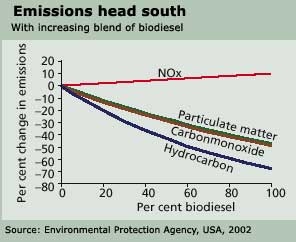Reduced emissions
 Although biodiesel is very similar to petroleum diesel, and can be used as a substitute, it is much cleaner a fuel. The emission of unburnt hydrocarbons, carbon monoxide and particulate matter is substantially lower than that from petroleum diesel. It has almost no sulphur, no aromatics, and about 10 per cent built-in oxygen that helps it burn fully. The cetane number is higher than many fuels (in the range 48-60), which improves the combustion. Non-regulated emissions like polyaromatic hydrocarbons, which are carcinogenic, have also been found to be lower.
Although biodiesel is very similar to petroleum diesel, and can be used as a substitute, it is much cleaner a fuel. The emission of unburnt hydrocarbons, carbon monoxide and particulate matter is substantially lower than that from petroleum diesel. It has almost no sulphur, no aromatics, and about 10 per cent built-in oxygen that helps it burn fully. The cetane number is higher than many fuels (in the range 48-60), which improves the combustion. Non-regulated emissions like polyaromatic hydrocarbons, which are carcinogenic, have also been found to be lower.
A number of studies, in India and abroad, have shown vehicular emissions are reduced when biodiesel is blended with diesel. Biodiesel requires very little or no engine modifications up to 20 per cent blend and minor modification for higher percentage blends. Without modification, higher percentage blends can be a problem because biodiesel has high viscosity: it can result in gum formation in engine parts like the fuel injector and cylinder liner.
Now the best part: it can be produced in India.
Related Content
- UN World Water Development Report 2025
- Reply affidavit Ministry of Jal Shakti on the impact of climate change on Himalayan glaciers, 07/03/2025
- A comparison of the life-cycle greenhouse gas emissions from combustion and electric heavy-duty vehicles in India
- Climate watch country greenhouse gas emissions data and methodology
- Climate risks to nine key commodities: protecting people and prosperity
- Assessing the scale of zero-emission truck deployment required for meeting India’s net-zero goal
